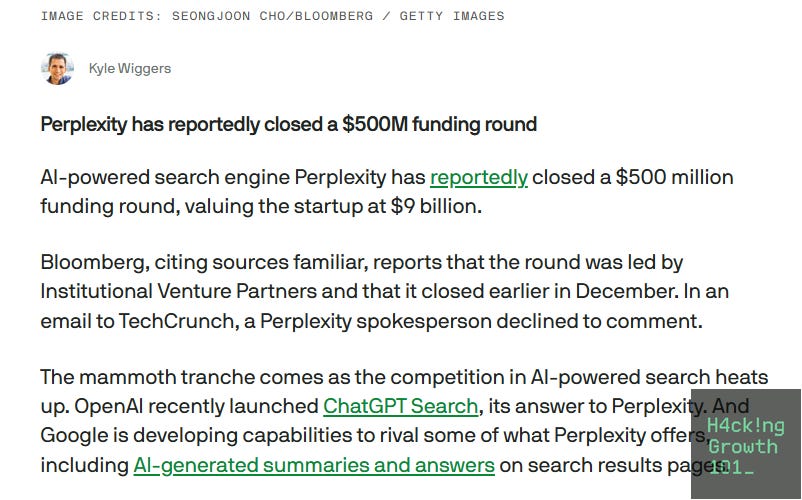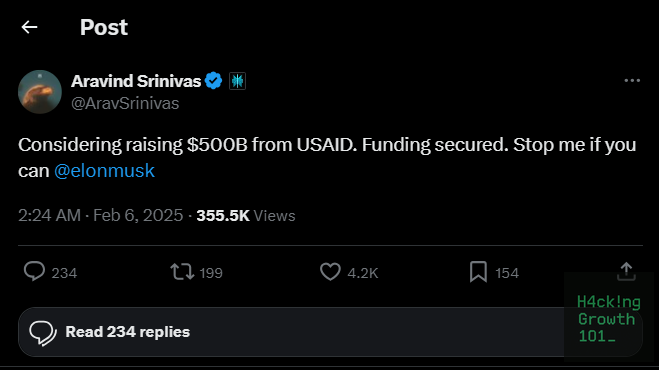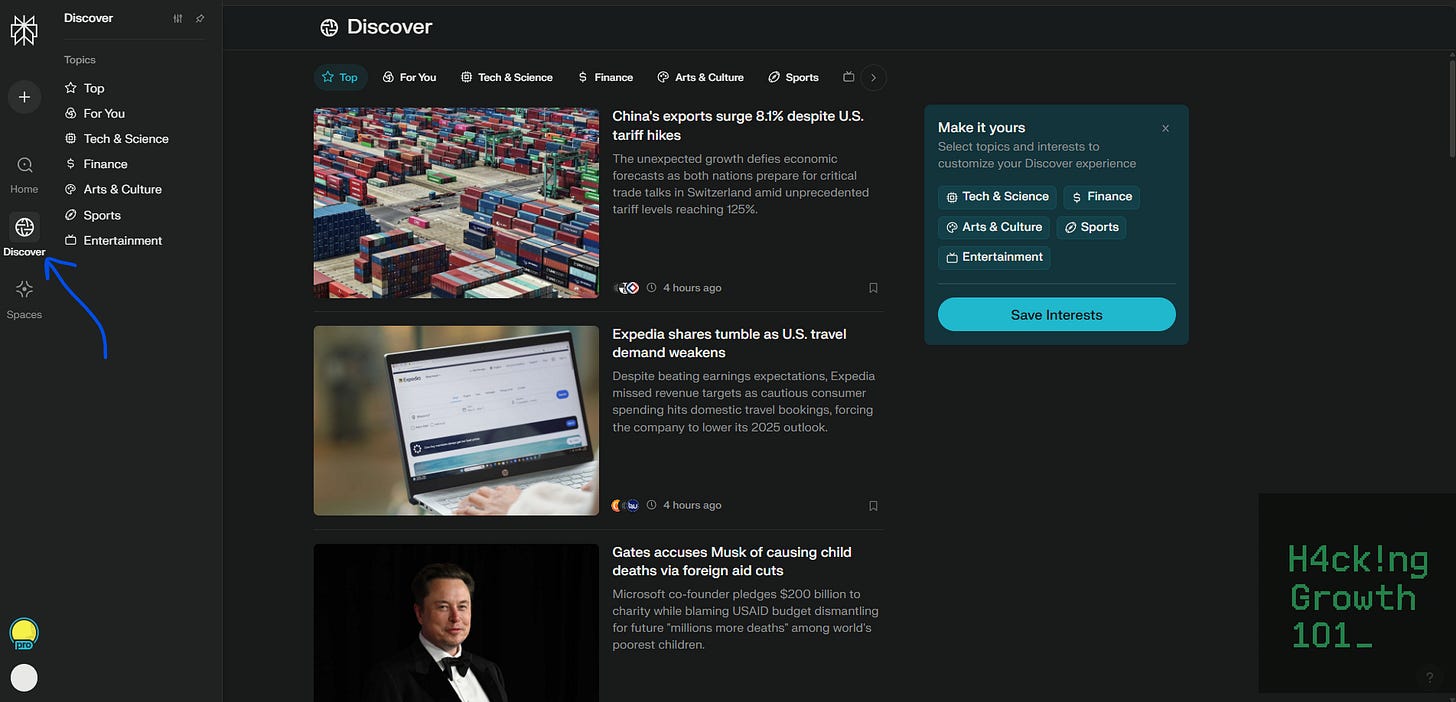How Perplexity Hacked Its Growth – Everything You Can Adopt from It
Unpacking the loops, product bets, and bold moves behind AI search’s fastest riser.
In just two years, Perplexity AI rocketed from an idea to a search startup valued at a jaw-dropping $9 billion. This AI-powered “answer engine” launched in late 2022 and swiftly amassed millions of users by offering something Google and ChatGPT didn’t – instant answers with trusted citations.
By February 2023, Perplexity was handling 10 million queries (2M unique users) per month. Fast forward to mid-2024, its traffic surged to an estimated 50–75 million visits monthly, and investors like Jeff Bezos and Nvidia poured in funding to fuel its rise.
Other publications that you might have missed:
How it all started?
Perplexity AI was founded in August 2022 by Aravind Srinivas (CEO) alongside Denis Yarats, Johnny Ho, and Andy Konwinski – engineers hailing from OpenAI, Quora, Databricks and other AI-heavy backgrounds.
Frustrated by the “endless list of links” that traditional Google search served up, Srinivas envisioned a “conversational answer engine” that could deliver direct answers with evidence.
They officially launched Perplexity.ai in December 2022 as a free public beta, positioning it as the fastest way to get answers to any question. Unlike ChatGPT (which had just debuted with no source citations) or Bing’s search, Perplexity combined the strengths of both: an LLM-driven chatbot interface that summarizes web results with inline citations.
This hit a sweet spot. Within two months, the site was already attracting tech-savvy users in droves – 2 million unique visitors in February 2023 alone.
Early adopters raved on Hacker News and Twitter about finally having Google results without the spam, fueling a word-of-mouth surge.
Perplexity’s commitment to accuracy (each answer linked to sources) was a key differentiator that built trust and curiosity among users searching for credible information.

The founding team used their backgrounds to position Perplexity cleverly in the market. Having ex-OpenAI and Quora talent onboard lent credibility in building a cutting-edge AI search tool. And rather than taking on Google head-on in a feature-for-feature race, Perplexity carved out a product gap: delivering answers with citations in a conversational format.
As Srinivas put it, “With Perplexity, users can get instant answers to any question with full sources and citations included. [It] is for anyone and everyone who uses technology to search for information.”
That clear value prop helped Perplexity gain initial traction despite the presence of much larger players. The product quickly found a loyal early user base who not only used it frequently but also championed it to others.
Growth Timeline
[you can skip it…😉]
Perplexity’s growth can be tracked through a series of product launches and growth spurts. Here’s a quick timeline of the pivotal moments and metrics in its journey:
Dec 7, 2022:
Public launch of Perplexity’s flagship AI search engine (web app). Users can now ask questions in natural language and get answers with cited sources.
The simple chat UI and reliable answers immediately start spreading on tech forums.
Feb 2023: Usage explodes –
Perplexity reports 10 million visits and ~2 million unique users in the month. (For comparison, Google does tens of billions, but 2M uniques so early is huge for a new tool.)
This validates strong product-market fit among early adopters.
April 4, 2023: Series A funding & iOS app launch.
The company raises $26M led by NEA (with angels like former GitHub CEO Nat Friedman and Meta’s Yann LeCun).
That same day, they release the Perplexity iOS app, expanding into mobile.
By now, Perplexity is handling millions of queries per day and establishing itself as a top AI search alternative.
Mid-2023:
Perplexity quietly rolls out a browser extension for Chrome, allowing users to search via Perplexity directly from their browser toolbar, aiming to intercept search habits right at the source, and further driving usage.
The team also continues rapid feature updates, improving accuracy and adding capabilities (e.g. the ability to follow up questions in a thread).
Jan 4, 2024: Series B funding.
Perplexity announces a $73.6M raise led by IVP (participants include Databricks Ventures, Elad Gil, Tobi Lütke, and even Jeff Bezos). This round values the startup at $520M post-money.
By this point – barely 16 months since founding – Perplexity claims 10 million monthly active users using its search assistant. The team is still lean (under 40 employees) but growing.
April 2024: Valuation hits $1B+.
Perplexity raises about $63M at a valuation over $1 billion. This doubles the company’s valuation in one quarter, reflecting red-hot investor enthusiasm for generative AI.
Product usage is surging: in the first part of 2024, Perplexity handled nearly 75 million user questions in the U.S. – more queries in a few months than in all of 2023.
The company also inks distribution partnerships with Japan’s SoftBank and Germany’s Deutsche Telekom around this time, aiming to bring Perplexity to potentially 300+ million mobile customers (with free one-year subscriptions as a promo). This global push sets the stage for the next growth leap.
July 30, 2024: Publisher Program launch.
To preempt mounting concerns from publishers about AI bots scraping content, Perplexity announces a new program to share ad revenue with content publishers.
Essentially, they start cutting checks to publishers in exchange for using their content – a strategic move to mitigate “plagiarism” accusations and keep the platform’s access to high-quality information sources.
This move is lauded as a proactive step in a time when many AI companies faced backlash for using news content without permission.
Nov 18, 2024: Shopping integration.
Perplexity launches a new AI “Shopping” hub with backing from Amazon and Nvidia. Now users asking product-related questions get rich product result cards and recommendations.
This not only improves the user experience for shopping queries but also hints at future monetization via affiliate links or ads (and indeed, sharing revenue with publishers/retailers).
Dec 2024: $9B valuation secured.
Perplexity closed $500M in new funding (Series C) at a valuation of approximately $9 billion. Investors in this round include IVP (leading again) and notable names like Jeff Bezos, Nvidia, and Databricks among others.
In total, the company has grown to about 100 employees by the end of 2024. The fresh capital is earmarked for further R&D (running those expensive AI models) and a push into enterprise offerings.
Jan 2025: Android “Assistant” launch & bold PR move.
Perplexity kicks off 2025 by releasing “Perplexity Assistant” for Android, an AI companion app that integrates deeply with the Android platform. This hints at ambitions to become a default assistant on mobile devices.
Then, in a headline-grabbing twist, Perplexity’s CEO Aravind Srinivas publicly offers to merge Perplexity with TikTok U.S. in light of a possible TikTok ban. While largely a publicity stunt, this move demonstrated Perplexity’s appetite for bold, unconventional growth moves – and it earned them mainstream media attention (USA Today, etc.) during a hot news cycle.
Feb 2025: Continued growth & new tools.
By this time, Perplexity’s user base has grown to over 15 million monthly active users. The company introduces a “Deep Research” mode that can autonomously research and compile reports (initially a paid feature, now made free), aiming to increase engagement from power users like students and analysts.
The CEO also engages in a viral Twitter exchange, challenging Elon Musk (who had criticized U.S. government funding of AI) with a tongue-in-cheek post:
This playful jab at Musk garnered press coverage and showcased Perplexity’s confident, if not audacious, attitude on the public stage.
As of early 2025, Perplexity stands as one of the most-watched AI startups in the world – not just for its hefty valuation, but for how effectively it has translated AI tech into a product that millions use regularly.
Six Compounding Growth Loops
How Perplexity Drives Exponential User Growth?
Perplexity engineered self-reinforcing growth loops that continuously bring in users. Here are six key growth loops it employed, and how each one worked:
Curiosity & Engagement Loop Conversational search breeds more questions.
A user asks one question, gets a useful answer with sources, and is naturally prompted to ask follow-ups (“Ask a follow-up” is built right into the UI).
This Q&A dialog format turns a single query into a multi-question session. In fact, the average user session on Perplexity lasts nearly 11 minutes – implying users keep exploring.
Each answer often surfaces new info and related topics, sparking the user’s curiosity to dig deeper.
This loop of question → answer → new question increases user engagement and total queries per user, which in turn improves Perplexity’s model (learning from more interactions) and boosts its search index coverage.
The more answers users get, the more value they derive (and the more habit-forming the product becomes).
Shareable Knowledge Loop Users generate content that attracts more users.
Every question asked on Perplexity (along with its answer and sources) essentially creates a rich piece of content. Perplexity highlights popular queries in a public “Trending” or “Discover” feed for all users.
For example, if someone asks “What’s the least visited country?” and it gets an interesting answer, other users see it and click that topic – which triggers them to use Perplexity for their own questions.
Users can also share links to answers or even create “Pages” (custom knowledge pages) from their research to share externally. These shared answers and pages bring in new visitors who encounter Perplexity content on social media or via search.
It’s a viral loop: one user’s query can spark hundreds of others to view that answer or ask related questions themselves. As more people use and talk about Perplexity’s answers, the platform gains free exposure and traffic (user-generated SEO).
Freemium Conversion Loop Free usage drives virality, paid upsells fund growth.
Perplexity’s core product is free, lowering the barrier for anyone to try it. Millions of users used it without friction, driving the viral loops above. Power users who hit limits or want more advanced features are funneled to the paid Pro plan ($20/mo). The Pro tier unlocks extra capabilities (like GPT-4 and Claude models, file uploads, faster responses) – this monetizes the most engaged users.
Crucially, the revenue from these subscriptions (and enterprise sales) gets reinvested into improving the free product (better AI models, new features). That makes the free version even more attractive, pulling in more new users.
This freemium loop means Perplexity can sustain offering a powerful free service that keeps viral growth high, while still generating revenue to scale up.
AI Data Feedback Loop More usage → smarter answers → more usage.
Every time users pose questions, Perplexity’s systems learn. The team uses a “modern PageRank” approach and data from past queries to continually refine search results and citations.
In essence, user interactions feed back into the AI, improving its ability to answer future questions accurately. As answers get better and more trustworthy over time, users are more likely to come back (retention) and new users are more impressed (conversion).
This creates a self-reinforcing cycle: growing usage improves the product, and a better product attracts more usage. Aravind Srinivas emphasized building a trust map of the web and iterating quickly based on real user questions, which helped Perplexity “distinguish its chatbot in an increasingly crowded market”.
Unlike static search engines, Perplexity’s model is continually learning from feedback (e.g., which sources users click, which follow-up questions they ask). That continuous improvement keeps the growth flywheel turning.
Multi-Platform Distribution Loop Be everywhere users are.
Perplexity aggressively expanded beyond a web app: it launched on iOS and Android mobile (with over 5 million+ app downloads by 2024), released a Chrome browser extension, and even integrated as an AI assistant on Android.
Each new platform opened the door to new user segments and use cases – e.g. mobile apps tap into on-the-go searches and App Store discovery, while the browser extension lets users replace default Google search.
The company also struck deals with major telecoms (SoftBank, Deutsche Telekom) to pre-install or promote Perplexity to hundreds of millions of smartphone customers.
These distribution channels create a compounding effect: as more users find Perplexity pre-installed or easily accessible, usage jumps, which encourages more partners to collaborate (seeing its popularity).
It also increases direct traffic; by mid-2024, a remarkable 68% of Perplexity’s traffic was direct (users navigating straight to the app/website) – a sign that it’s becoming a habit.
By being ubiquitous across devices and networks, Perplexity ensures it captures users wherever they might search, reinforcing growth on all fronts.
Hype & Media Loop Buzz begets growth, which begets more buzz.
Perplexity has expertly used PR and media to accelerate adoption. Each big funding announcement and milestone (e.g. “Perplexity valued at $1B+”) generated press articles, which introduced the tool to new audiences.
Tech influencers and VCs tweeting about Perplexity’s potential as a “Google challenger” further amplified interest.
The team isn’t shy about bold PR moves – from the TikTok merger bid (which landed headlines in national media) to the CEO’s viral banter with Elon Musk (covered by tech news), they managed to keep the company in the conversation.
This attention translates into surges of new users checking out the app. In turn, rapid user growth (10M→15M MAU) gives more fodder for media stories, continuing the cycle.
Even controversies have been flipped into opportunities to demonstrate leadership or vision, resulting in more coverage.
By strategically riding the hype cycles around AI and making newsworthy moves, Perplexity created a media-driven growth loop that many startups envy – essentially getting millions in free marketing and brand awareness.
Each of these loops reinforced the others – for example, media buzz drove new users to try the free product, whose engagement loops increased usage data to improve the AI, which made the product more shareable and sticky, and so on.
The result: compounding growth. Perplexity went from 0 to 10M+ users in roughly a year, and kept accelerating.
Retention & Monetization Tactics – Habit Formation and Revenue Drivers
Growing fast is one thing – keeping users and making money is another. Perplexity focused not only on acquisition but also on building habits and a business model. Here’s how they approached retention and monetization:
Daily Habit Loops:
Perplexity’s conversational design encourages frequent use. Users often start with a quick question and end up on a mini “learning journey” through follow-ups. The data shows strong engagement – an average session is nearly 11 minutes long, and many users return multiple times a day.
To reinforce this habit, Perplexity added features like a “Discover” feed showcasing trending questions. This gives users a reason to open the app even when they don’t have a specific query – much like one might browse trending topics on Twitter out of curiosity.
Additionally, the mobile apps likely send subtle notifications (e.g. “Your answer summary is ready!” or tips on what others are asking) to draw users back in.
By meeting users’ information needs in real-time and showing fresh content, Perplexity positions itself as a go-to daily tool – like a modern AI encyclopedia that you instinctively consult whenever a question arises.
User Accounts & Personalization:
To deepen retention, Perplexity allows users to sign up and save their conversation history. Logged-in users have a Library for saved threads and can even create Pages (shareable research summaries). This means as you use it, you’re building a personal knowledge repository – increasing switching costs.
They also introduced “Copilot” personalization for Pro users (which learns your preferences over time). These features make the experience more tailored the more you use it, giving users a sense that their Perplexity gets better over time.
It’s a classic retention mechanism: invest users in the product (via saved data, custom settings) so that they are less likely to drop off.
Regular Feature Drops:
The team kept up a brisk cadence of new feature releases that re-engage the user base.
For example, the Finance search tools (launched Oct 2024) let users ask for stock prices or financial summaries – attracting professionals and giving existing users new reasons to stay within Perplexity for tasks that might have required a separate finance app.
The Shopping recommendations feature added e-commerce searches, expanding the use cases for everyday users. And in early 2025, they made the advanced “Deep Research” mode free for all, letting users generate in-depth reports with multiple searches.
By constantly expanding what users can do on the platform, Perplexity reduces the temptation to go back to Google or other tools.
Each update is also an opportunity to reach out with emails or notifications (“New on Perplexity: Shopping answers!”), pulling users back in to try the new capabilities.
Monetizing Search Intent (Carefully):
Beyond subscriptions, Perplexity has begun experimenting with more traditional search monetization – but in user-friendly ways.
The Shopping hub is one example: when users ask about products, the answer includes product cards (with images, prices, links). This is likely backed by Amazon, meaning Perplexity could earn affiliate commissions or ad revenue share from purchases.
They’ve also started an ad-revenue sharing program with publishers, hinting that sponsored results or contextually relevant ads might appear, with a cut going to content providers. The key is that they’ve approached this gingerly, to avoid degrading user experience or trust.
Any monetization through ads is being done in a transparent, partnership-driven way (very unlike how Google mixes ads into results). This strategy turns a potential friction point (publishers vs. AI) into a monetization win-win: users still get answers with sources, publishers get paid for their content being used, and Perplexity can generate advertising revenue without alienating its user base.
It’s a smart path to eventually monetizing high-intent queries (shopping, finance, etc.) while keeping the core product appealing.
Behavioral Nudges & UX Design:
Perplexity’s interface itself is optimized to keep users engaged. Inline citations not only build trust but also invite the user to click and read more (“hmm, let me check that source”).
The ability to ask follow-up questions with one click makes it effortless to continue the session. Little touches like highlighting “Related Topics” or allowing users to switch search scopes (e.g. limit to academic papers, or see trending community questions) provide continuous prompts to explore.
Even the branding of the service as a friendly “AI Companion” (as seen on the mobile app stores) and the one-tap browser extension integration are nudges to use Perplexity in more situations (the extension literally puts a Perplexity icon in your browser bar – a constant reminder).
All these design decisions reinforce a habit loop: Need info → use Perplexity → get instant good answer → (follow up or save it) → repeat next time.
Over time, a sizable chunk of users have made Perplexity their default way to search (by direct navigation or setting it as default in browser), which is the ultimate goal of retention.
On the whole, Perplexity has been converting first-time curious visitors into long-term users by delivering immediate value (fast, accurate answers) and then deepening the relationship with accounts, useful features, and only gentle monetization pressure.
Growth Hacker’s Checklist: What You Can Learn from Perplexity
For startup founders and growth hackers, Perplexity AI’s playbook is a goldmine of insights. Here are the most important takeaways distilled into bite-size nuggets:
Solve a real pain point better than incumbents. Perplexity tackled the frustration of digging through links and ads for answers. By delivering direct answers with sources, they dramatically improved the search experience.
When your product truly eases a pain, users will do a lot of your marketing for you through word-of-mouth.
Leverage freemium + product-led growth. Lowering friction was key to Perplexity’s adoption. They let everyone try the core product free, which drove rapid viral uptake. Monetization was layered later with a compelling upgrade path. The lesson: get users hooked on value first.
If you can afford to, delay monetization until you achieve scale and engagement; then even a small conversion rate can sustain you.
Design for engagement and compounding usage. Perplexity’s interface literally invites you to ask follow-up questions and explore related topics, turning usage into an addictive loop. Think about how your product can prompt users to stick around longer or come back. Features like personalized feeds, trending content, or saved progress can convert one-time users into habitual ones.
The more they use it, the more content/data gets created to attract yet more users (a positive flywheel).
Meet users where they are. One growth hack Perplexity nailed: multi-platform presence. They didn’t wait to only be a web app – they launched mobile apps, browser extensions, and integrations quickly. By being ubiquitous, they intercepted users in their natural habitats (phone, desktop, etc.).
Distribution, Distribution, Distribution: consider browser extensions, Slack apps, APIs, strategic partnerships – any channel that can plug your product into users’ existing routines.
Turn users into evangelists (and content creators). Perplexity benefited from users sharing cool answers and creating content (Pages). Perplexity’s “Discover” section essentially crowdsourced interesting use cases, which both retained curious users and showcased social proof that “people like me find this valuable.”
When users publicly praise or utilize your product, amplify it. Encourage sharing with easy link exports or social share buttons. Community-driven content is a free growth engine.
Growth loops beat funnels. Instead of linear acquisition funnels, think in loops. Perplexity’s growth was from loops that continuously fed themselves (users bringing more users, usage improving product, etc.).
As you strategize, identify at least one self-reinforcing loop. For example, user content → SEO traffic, or free tool → data → network effect. A loop might start slowly, but once it spins up, it’s far more powerful than a funnel that requires constant top-up.
Prioritize trust to reduce friction. In an era of misinformation, Perplexity gained user trust by being transparent (every answer had cited sources). This not only drew users from less-trusted platforms, but also preempted many concerns.
For growth, trust is a force multiplier – reviews, referrals, and retention all improve when users believe in you. So invest early in credibility (through quality, transparency, customer support) even if it doesn’t give immediate growth, it removes barriers to growth.
Be bold in marketing (but align it with your mission). Perplexity’s cheeky PR moves got it free coverage. The takeaway isn’t “go generate controversy for attention,” but rather don’t be afraid to loudly stand for something.
If there’s an opportunity to insert your startup into a larger conversation, seize it with a creative angle. Just make sure it fits your brand’s personality and values, so it comes off authentic.
Align your monetization with usage, not against it. Perplexity avoided showing spammy ads or paywalling answers – tactics that might have squeezed short-term revenue at the cost of user growth. Instead, they monetized in ways that enhance the product for power users (Pro features, enterprise services) and create ecosystem value (revenue share with content providers).
When devising your business model, try to make each dollar you earn correlate with a better experience for users, not a worse one. This keeps the growth flywheel spinning even as you monetize.
By following this playbook, you’ll grow sustainably and explosively, just like Perplexity AI.
Their journey from scrappy startup to $9B valuation in two years is proof that with the right product-market fit and a network of compounding growth loops, a newcomer can shake up even the most entrenched industries.
Now it’s your turn to adopt these strategies and hack your own growth story!
Happy growth hacking!













Insightful read! I tried Perplexity but I feel as compared to ChatGPT it lacks conversational capabilities. Would love to know your thoughts